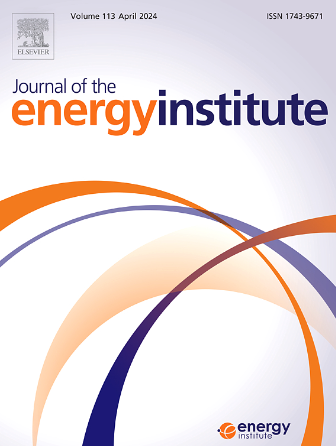Study on the impact of C-CaO dual-based-loaded catalysts on the co-gasification of biomass and plastics in the steam atmosphere
IF 5.6
2区 工程技术
Q2 ENERGY & FUELS
引用次数: 0
Abstract
In this study, salix psammophila (SL) and plastic mulch film (PMF) used in farmland were employed as experimental feedstocks. Coconut shell char (HCSC) was utilized as the carbon support for the preparation of HCSC-CaO dual-based-loaded catalysts. Co-gasification experiments were carried out under a steam atmosphere to evaluate the performance of these catalysts. Various experimental parameters, including different Ni/Fe loading ratios, SL and PMF blending ratios, reaction temperatures, and steam flow rates (H2O/C), were investigated to assess the performance of catalyst in terms of H2 yield and CO2 adsorption. Under optimal conditions (feedstock ratio (SL:PMF = 3:1), gasification temperature of 800 °C, and H2O/C = 4), the Ni-Fe/HCSC-CaO (Ni:Fe = 1:1) catalyst exhibited a high H2 yield (793.4 mL/g) and a low CO2 yield (102.0 mL/g). Additional metals (Co, Ce, and Al) were introduced for modification to further enhance the catalytic activity. Among them, the Al-Ni-Fe/HCSC-CaO catalyst (Ni:Fe = 1:1) demonstrated superior catalytic activity, yielding 882.8 mL/g of H2 and 107.2 mL/g of CO2. Cyclic experimental tests confirmed the catalyst's excellent thermal stability and high H2 selectivity. This research presents a novel strategy for the efficient co-gasification of biomass and plastic to produce hydrogen-rich syngas.

C-CaO双基负载催化剂对生物质和塑料在蒸汽气氛下共气化的影响研究
本研究以沙柳(salix沙柳)和农田地膜(PMF)为试验原料。以椰壳炭(HCSC)为碳载体,制备了HCSC- cao双基负载催化剂。在蒸汽气氛下进行了共气化实验,以评价催化剂的性能。考察了不同Ni/Fe负载比、SL和PMF掺合比、反应温度和蒸汽流量(H2O/C)等实验参数对催化剂H2产率和CO2吸附性能的影响。在最佳条件下(进料比(SL:PMF = 3:1),气化温度为800℃,H2O/C = 4), Ni-Fe/HCSC-CaO (Ni:Fe = 1:1)催化剂H2产率高(793.4 mL/g), CO2产率低(102.0 mL/g)。此外,还引入了Co、Ce和Al等金属进行改性,进一步提高了催化活性。其中,Al-Ni-Fe/HCSC-CaO催化剂(Ni:Fe = 1:1)表现出较好的催化活性,H2产率为882.8 mL/g, CO2产率为107.2 mL/g。循环实验证明该催化剂具有良好的热稳定性和较高的H2选择性。本研究提出了一种生物质和塑料高效共气化生产富氢合成气的新策略。
本文章由计算机程序翻译,如有差异,请以英文原文为准。
求助全文
约1分钟内获得全文
求助全文
来源期刊

Journal of The Energy Institute
工程技术-能源与燃料
CiteScore
10.60
自引率
5.30%
发文量
166
审稿时长
16 days
期刊介绍:
The Journal of the Energy Institute provides peer reviewed coverage of original high quality research on energy, engineering and technology.The coverage is broad and the main areas of interest include:
Combustion engineering and associated technologies; process heating; power generation; engines and propulsion; emissions and environmental pollution control; clean coal technologies; carbon abatement technologies
Emissions and environmental pollution control; safety and hazards;
Clean coal technologies; carbon abatement technologies, including carbon capture and storage, CCS;
Petroleum engineering and fuel quality, including storage and transport
Alternative energy sources; biomass utilisation and biomass conversion technologies; energy from waste, incineration and recycling
Energy conversion, energy recovery and energy efficiency; space heating, fuel cells, heat pumps and cooling systems
Energy storage
The journal''s coverage reflects changes in energy technology that result from the transition to more efficient energy production and end use together with reduced carbon emission.
 求助内容:
求助内容: 应助结果提醒方式:
应助结果提醒方式:


